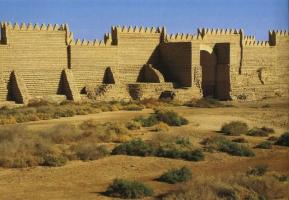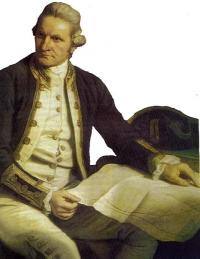The Hanging Gardens of Babylon

Did you see that Secrets of the Ancients programme on 30 November 1999?
I don't think it really matters who built the gardens, whether Nebuchadnezzar II of Babylon [r. 605-562 BC] or Sennacherib of Nineveh [r. 705-681 BC], but the actual technological achievement of their design and construction. Babylon stood close by the Euphrates river, and its ruins can be seen near the town of Al-Hillah, Iraq. Nineveh, the Assyrian capital, was sited at the confluence of the Tigris and Khosr, and inhabited almost continuously from 6000 BC to 1500 AD.
As was pointed out in the programme, there is no substantive evidence of their exact location [as yet] despite their fame as one of the Seven Wonders! Regarding their appearance, classical writers have left us an impression of a structure that was 'terraced' rather than 'hanging', forming an artificial hill in an otherwise flat terrain. It was a ziggurat or stepped pyramid, its tiers "held up by large arches, raised upon other arches, one above the other to a height of more than 100 metres, and strengthened by a wall seven metres thick surrounding the entire gardens."
[The Book of Knowledge, London, 1982, PG 109]
Large flat stones on the arches were covered with lead, bitumen and reeds to prevent water seepage. The shrubs and trees were planted in earth on the stones. The Gardens were irrigated by "a pump on the top tier" [ibid., pg. 109] drawing up water from the river. The terraces were connected by steps "three metres wide" [ibid., pg. 109]. Early in the 20th century, a German archaeologist, Robert Koldewey, "did uncover an unusual series of foundation chambers and vaults in the north-eastern corner of the palace at Babylon. A well in one of the vaults may have been used in conjunction with a chain pump and thus was perhaps part of the substructure of the... Hanging Gardens."
[Encyclopaedia Britannica CD ROM, 1994-98]
According to tablet inscriptions found on the staircase, the "cellar" was a storeroom for food. With all that stone it certainly would've been cool in there. What I found most interesting about the conclusions of historian Stephanie Daley on the programme was the idea of whichever king using the Archimedes Screw Pump to irrigate the terraces. She rejected the idea of a series of shadoofs [a machine for raising water by a bucket on a counterpoised pivot rod] as impractical, and, similarly, I discount both the roof pump and basement well. This is because curious passages in cuneiform tablets suggested the screw method, as well as how they were cast [that would've been an amazing accomplishment in itself]. If true, then the screw pump was in use almost half a millennium earlier than originally thought! A Ninevan wall relief shown on the programme gave a good idea of the appearance of the Gardens. Using that image I drew the following diagram:The virtual image at the end of the programme suggested it was more practical to water the terraces individually than have one or two large screw pumps irrigating the whole Gardens. For one thing less power would've been required. Based upon the available evidence, this is how I think it was done:
Pairs of Archimedes Screw Pumps [B] rotated to draw up water from the Tigris [A] to the lowest tier. Each subsequent level then pumped water up from channels on the terrace below. The terraces were sloped to allow gravity to irrigate them. But, with an aqueduct [C] in the middle of two sides, and a central staircase on the other two, this meant that the front and back of the Gardens had to be irrigated separately. Thus, the schematic above would've been replicated round the back. Therefore, to make this work, the terraces were angled downward towards each side of both aqueducts. Like the Roman Pont du Gard, France, the aqueducts consisted of several tiers of arches. The water from each terrace flowed onto a different level. If that is the case, where did the back pumps draw water from? My answer is that the Gardens were moated with water from the Tigris directed around the base of the ziggurat [Middle Eastern stepped pyramid]. The aqueducts channelled the water away to supply the city. The staircase[s] allowed the King, Queen and court to view and admire the Gardens and look out over the city from a belvedere at the top [D].
But how did the screw pumps operate? The archaeologists and engineers suggested either human or animal power, though I think the actual method was more sophisticated than that. A big clue lay in a cuneiform text mentioning chains and ropes. This, and the following passages from Erik Abranson's Ships of the High Seas [?, 1976, PGs. 18 and 20], got me thinking:
"Compared to oars and even hand paddles, paddle-wheels [the Romans had these] and Archimedean screws were not efficient when operated by muscle power. It was not until the steam engine was invented that they came into their own.""The principle of the steam turbine had been known for almost two thousand years when it was first used by the American John Stevens to propel a boat... around 1800."
Hero of Alexandria [c.20-c.62 AD], a Greek scientist, invented an ingenious way of making huge temple doors appear to open and shut without human impetus. As fire heated the altar, steam built up, and the doors, operated by concealed rods, weights and balances, swung into action.




























